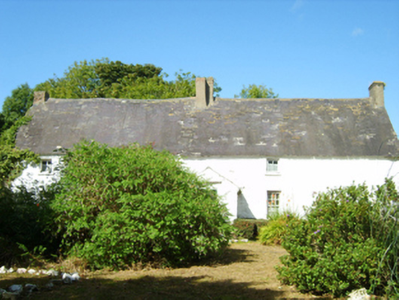Survey Data
Reg No
15704215
Rating
Regional
Categories of Special Interest
Architectural, Artistic, Historical, Social
Original Use
Farm house
Date
1700 - 1735
Coordinates
300263, 117990
Date Recorded
17/09/2007
Date Updated
--/--/--
Description
Detached six-bay single-storey lobby entry farmhouse with half-dormer attic, extant 1735, on a T-shaped plan off-centred on single-bay single-storey gabled projecting porch. "Improved", pre-1903, producing present composition. Occupied, 1911. Now disused. Pitched slate roof with clay ridge tiles, rendered coping to gables with rendered red brick Running bond chimney stacks to apexes centred on rendered red brick Running bond chimney stack on a T-shaped plan having corbelled stepped capping with pots now missing, and remains of cast-iron rainwater goods on limewashed red brick header bond stepped eaves. Part creeper- or ivy-covered limewashed lime rendered battered walls. Square-headed off-central door opening in square-headed recess with concrete step threshold, and concealed dressings including timber beam lintel framing glazed timber boarded or tongue-and-groove timber panelled door. Square-headed window openings with limewashed sills, and concealed dressings including timber lintels framing six-over-six timber sash (ground floor) or timber casement (half-dormer attic) windows with four-over-four (ground floor) or three-over-three (half-dormer attic) timber sash windows to rear (north) elevation. Set in unkempt landscaped grounds.
Appraisal
A farmhouse identified as an important component of the early eighteenth-century vernacular heritage of County Wexford by such attributes as the elongated rectilinear lobby entry plan form; the construction in unrefined local materials displaying a pronounced battered silhouette with a flaking surface finish revealing evidence of "daub" or mud; the disproportionate bias of solid to void in the massing compounded by the dramatic diminishing in scale of the openings on each floor; and the high pitched roofline: meanwhile, aspects of the composition clearly illustrate the continued development or "improvement" of the farmhouse at the turn of the twentieth century. A prolonged period of unoccupancy notwithstanding, the elementary form and massing survive intact together with substantial quantities of the original fabric, including some crown or cylinder glazing panels in hornless sash frames, thereby upholding the character or integrity of the composition. Furthermore, adjacent "tin roofed" outbuildings (extant 1840); and a folly-like "columbarium" (extant 1840), all continue to contribute positively to the group and setting values of a neat self-contained ensemble having long-standing connections with the Carty family including Eliza Carty (----), 'Farmer' (NA 1911).

